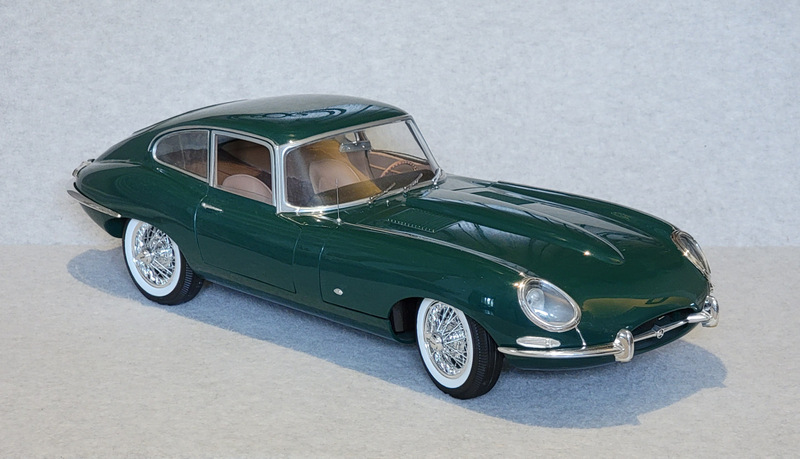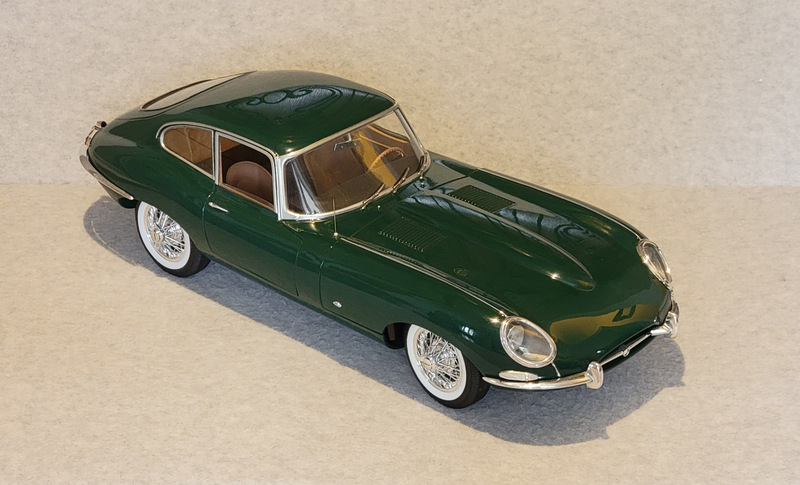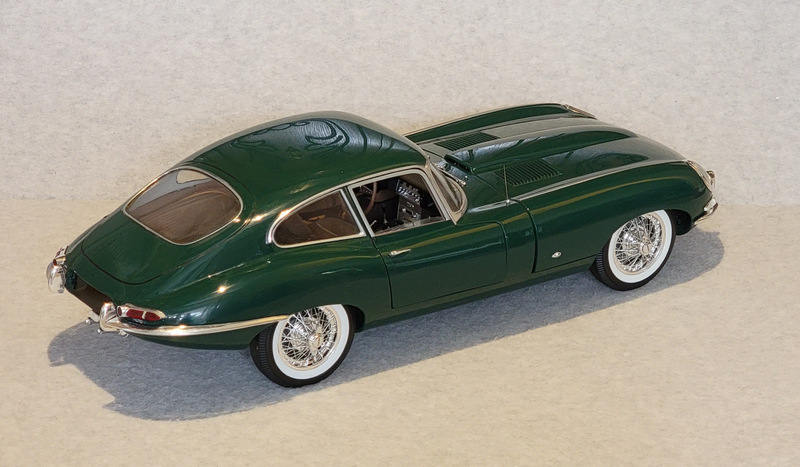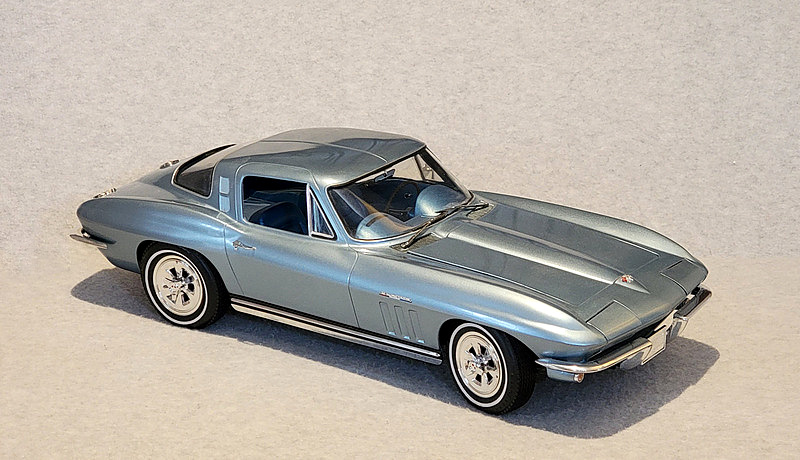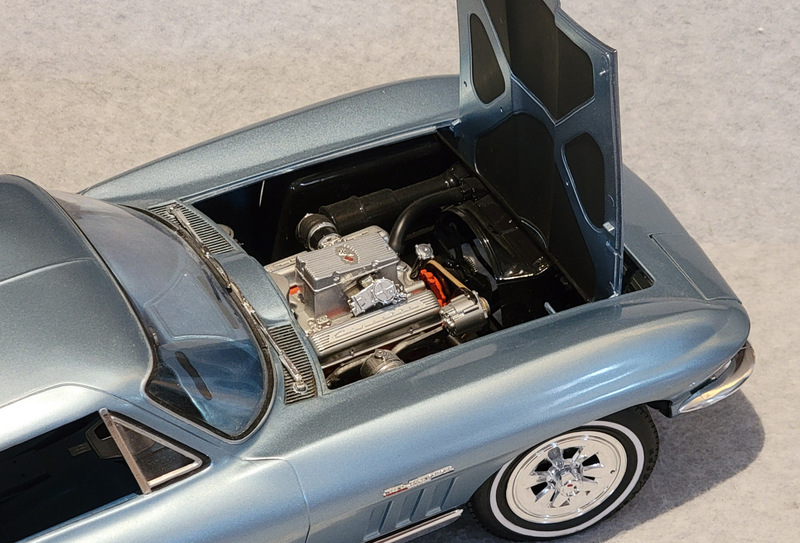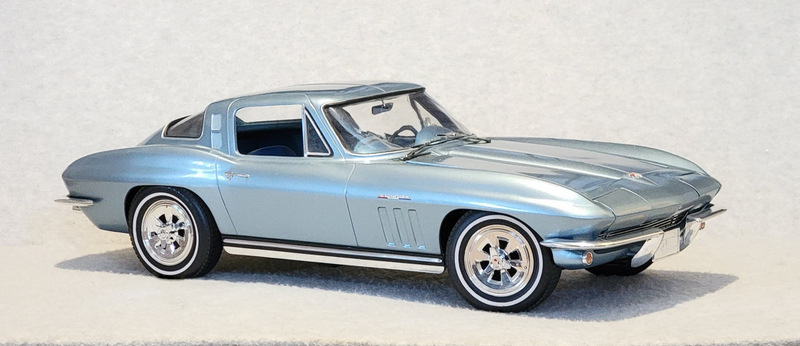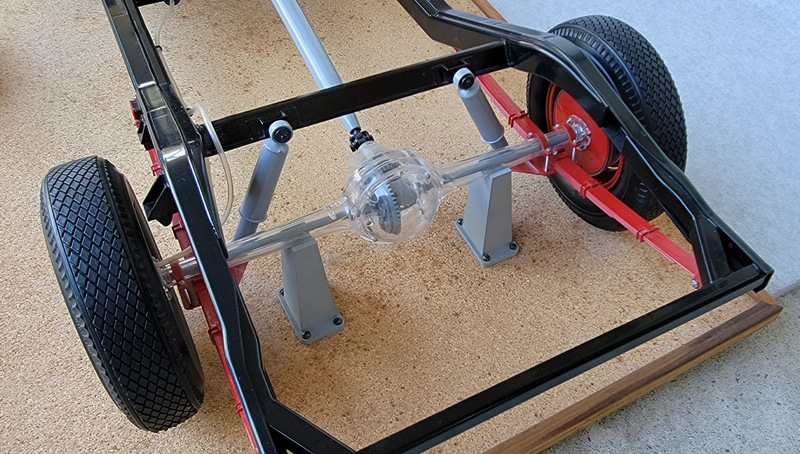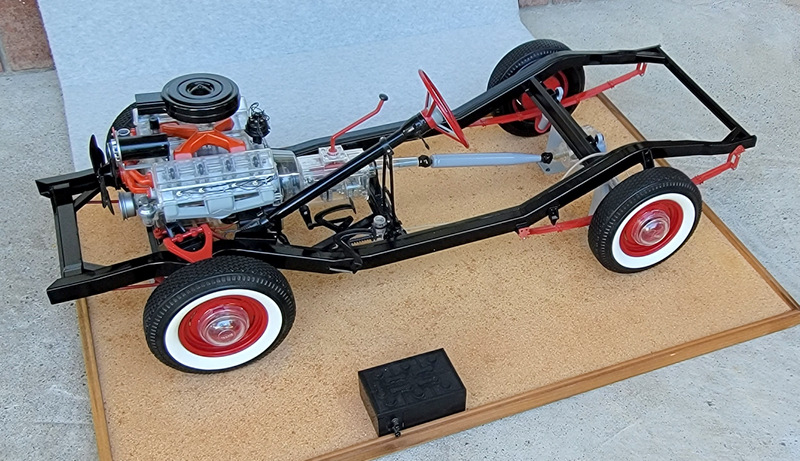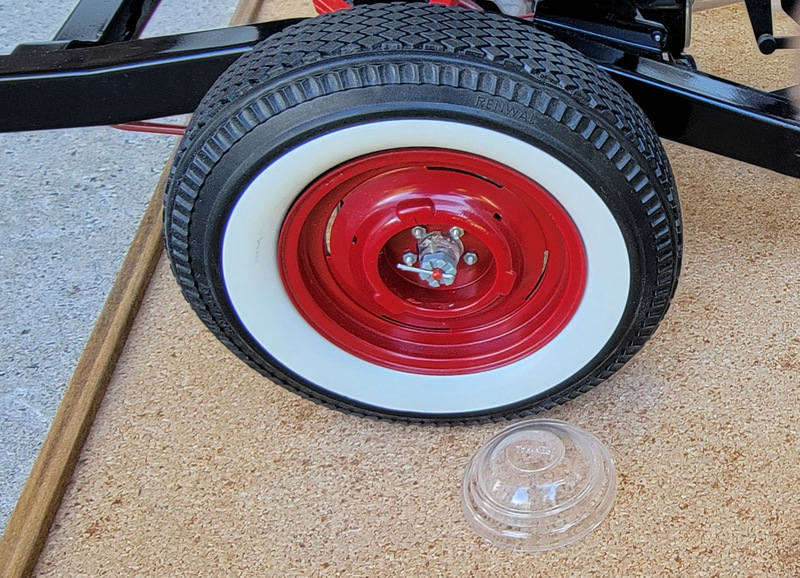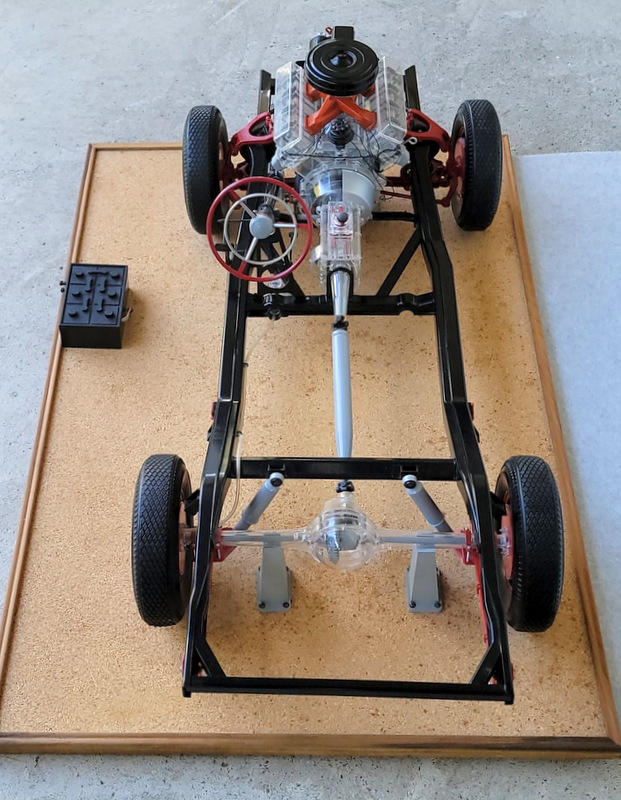
traditional
Members-
Posts
469 -
Joined
-
Last visited
Content Type
Profiles
Forums
Events
Gallery
Everything posted by traditional
-
The '49 Merc is a survivor model from the late '70s......no resin bodies or pre chopped tops back then This Cadillac powered '40 Merc mild custom was done recently by reproportioning and cutting open an old ITC kit
-
My wife and I have been packing and arranging for a 'downsize move' and with all the packing of my toy and model rooms (2), I've finally been able to, again, get my hands on a few old models that were in cases, but in areas that were difficult to access. The models are all large size.....a Monogram 1/8 scale Jaguar E-type, A Monogram 1/8 scale '65 Corvette Stingray, and a Renwall 1/4 scale 'Visible Chassis'. These models were all painted and built around 4 decades ago, and relatively inaccessible for about 20 years, but I've now been able to digitally photograph them. Enjoy!
-
I used both cyanoacrylate as well as 5 minute epoxy as adhesives. As for the handlebars, I still prefer using scissor-cut strips of quality aluminum muffler tape instead of the usual hobby foils. To me, it conforms better to curved surfaces and, using a fairly soft toothpick, you can burnish out most of the kinks that would otherwise cause bad reflections. I've been using the muffler tape for decades and ,as the saying goes, "practice makes perfect" I've also had fairly good luck with Alclad chrome lacquer over gloss black. It's only drawback, as with Molitow chrome, is a lack of durability if it gets handled a lot.. Attached is an example of the Alclad chrome lacquer over gloss black on another of my projects
-
I've just received this model, purchased from DHS Diecast in Ohio. These limited edition 1/50 resin models are quite expensive but they're also exceptionally well detailed and finished. I chose the green version simply because, to me, the least amount of chrome 'bling' enhances the realism. In their day, these were work-horses, not fancy show trucks. They come with a well finished, sophisticated felt base and acrylic cover During the late '50s and early '60s, the B81 series were Mack's heaviest duty trucks, using the familiar B series cab but distinguishable by the hard front fenders and large diameter wheels/tires.
-
Hi Bruce. The steam roller is a decades old 1/16 scale kit from Bandai. It's just taken me this long to finally paint and build it.
-
WOW, Geno!! That's super gorgeous. The interior and engine compartment detail as well as the paint and clean build style certainly does it for me. I enjoyed getting together with you at the final NNL Nationals a little over a year ago and I hope we'll get the chance to get together again sometime in the coming year.
-
Just a quickie addition.......Vent windows added as well as a trunk-lid hinged prop-rod It seems, I can't leave well enough alone!
-
'34 Full Fendered 5-Window Coupe (Olds powered) Model A 2-Door Phaeton (Chevy powered) Hino Super Profia 1919 Garrett Steam Roller '40 Mercury Convertible (Cadillac powered) '55 Pontiac Pathfinder (Canadian) Sedan Delivery
-
Hi Jay, Renshape is relatively easy to shape....it sands like soft wood but without the grain or moisture instability. In this case, I used a jeweler's saw to achieve the very basic form /size, and then used coarse sandpaper followed by 400 grit sandpaper. A bench grinder or a small bench belt-sander makes forming more major projects even easier. There's a lot of dust created, so wear a mask for safety (any fine dust can be harmful to your lungs, etc.). I made the bench seat in the three basic parts , then drilled and inserted short lengths of stiff wire to fasten the back-rests to the main base. The Renshape grade that I use (I got mine second-hand so I don't have the grade specs) is very durable with no airgaps, etc.
-
I’ve always had an affection for the ‘39/’40 Mercury convertibles….a little longer, chubbier, and heavier than the ’40 Fords, with a lower, softer rear fender opening and a nicely shaped soft top. In the early ‘60s, ITC made a 1/25 plastic kit of a ’40 Merc, but anyone who’s looked at those kits knows that the model is terribly disproportionate with very few useable parts or accessories. It was marketed as a remote-control model with no chassis to speak of and very rudimentary interior and engine compartment. I do enjoy a challenge, and with this ongoing pandemic and time on my hands, I decided to try my hand at ‘making a silk purse out of a sow’s ear’. After spending a lot of time reproportioning the main body, I decided to open and hinge the doors and trunk lid, and build a detailed, longer Merc chassis from a ’40 Ford version. I used stainless wire to form most of the body trim, a Revell parts-pack Cadillac motor (modified with a 3-2bbl intake and a ‘Replicas and Miniatures’ Cadillac air filter), chrome wheels from Pegasus with parts bin tires, and I added my usual fabricated brass rad, an aluminum fuel tank, aluminum strip transverse springs/shackles, polished aluminum exhaust system, and poseable steering front axle. I've even made the wire door handles to turn to open or latch the doors. Virtually every part on this model is either scratchbuilt or heavily modified. Paint is automotive basecoat/clearcoat custom mixed purple over a pearle base
-
Roger, you have such a clean build style......so impressive!!
-
Hi Geno, What a cool stock panel van......That's just the way I like to see 'commercial vehicles'. It doesn't look toy-like any more. Good stuff!
-
My brother and I have wanted to build one of these large 1/8 1956 to 1958 Volga kits for a while, but it was only available in Russia and sold as a subscription of 110 parts packages over a long period of time. Anyhow , an Ebay vendor in Russia was recently selling the complete set of packages unopened along with the 110 magazines that serve as building instructions. The wording is only in Russian, but the illustrations and photographs make it reasonably easy to follow the construction and it's much more pleasurable to have the complete kit of parts all at one time, so we pulled the trigger (it was expensive but the quality makes it worth the high cost). It's taken approximately seven full days to assemble the many hundreds of parts (everything comes painted) and I was amazed at the fit and finish of everything.....screw holes all line up well and they supply extra fasteners (tiny) in case one gets lost during the build. Theres a tiny speaker for the horn sound and all the lights work. I'm delighted with the result, and I find the model (and the real car) quite attractive.
-
The EXCLUSIVELY '32 Roadster/Cabriolet ONLY thread. Show us what you got!!!
traditional replied to mrm's topic in Model Cars
-
-
That is exceptionally nicely conceived and executed. Great stuff!
-
'Fire Replicas' recently introduced this exceptionally well detailed 1/50 scale '54 Autocar DC100T tractor with integrated sleeper to which my twin brother and I have added an appropriate mid '50s style refrigerated trailer. This setup of a 4x2 tractor with a 30' (or less) tandem axle trailer was somewhat of a 1950s standard package for east coast transport companies delivering into depos located within major cities. Our trailer began as a Matchbox Collectibles 1/50 Budwiser single axle trailer which we modified with tandem axles, standard '50s era landing gear and spare wheel rack. The reefer setup: a mid '50s Thermo King version was handmade using Renshape, aluminum and plated jewelry wire. The original 'Fire Replicas' Autocar tractor comes in a very nice display case, but since we wanted to mate it with a trailer we've transfered it all into a longer displaycase with an added felt base surface. Below: Fire Replica's Autocar tractor comes mounted in a nice display case
-
Brian lister founded a sportscar manufacturing company in 1954 in Cambridge England and in 1957 began developing a racecar with the Jaguar D-type drivetrain to compete in 1958. Later in 1958 they also offered their aerodynamic racecar , affectionately known as the ‘Knobbly’, with the Chevrolet Corvette drivetrain as well, and in 1959 even had Frank Costain design a new body for the Chevy drivetrain. The racing community’s move to rear-engines quickly made the front engined Listers obsolete, but there is a strong, almost cult- like interest in the old ‘Knobbly’ style racecars for historic racing now-a-days, many of them now Chevy powered, since the small-block Chevy engine is lighter and can produce more power, more cheaply. I’ve always liked the interesting look of the ’58 Listers and remember reading about them in Road and Track magazine (my very first subscription) in ’59 when I was just a 12 year old kid. Legacy Motors, the owners of the Diecast collectors Club forums recently offered the 1/18 scale Matrix resin ’58 Listers at less than half price and I quickly bought two of them….one to keep as the Lister Jaguar and the other to modify into a Lister Chevrolet, using internet reference for the typical visual detail changes……….usually early Halibrand mag wheels, heat extracting louvres on the top and side of the front hood, and often, exterior side pipes going into a long collector. The heat from the side exhaust usually mandates that the lower aluminum body panel is left unpainted. The Knobblies in historic racing also often have small scoops over the rear brake cooling holes, and just like many back in the day, generally have a roll bar over the behind-the-driver head fairing.
-
Absurdly detailed 1/64 Mercedes Actros car transport
traditional replied to traditional's topic in Diecast Corner
Not functional, but there are a couple of layout options and some spare parts. -
This beautifully finished and detailed diecast model is from Gaincorp GCD and includes lots of photoetch detail and very fine printing. The photoetch railings require installation by the purchaser and it comes with a bag of wheel chocks and optional deck arrangements to install in the appropriate locations if 1/64 cars are to be put in place. The quality packaging and brochure lead me to believe that this model is intended as a Mercedes truck promo
-
PGM evidently stands for 'Private Goods Model' , one of those unusual product names from China. The model is quite unbelievably detailed and the quality of assembly and finish is exemplary. My only nit would be that the wheels are a touch oversized, but I must admit they're beautifully crafted. The model comes beautifully packaged in a spiffy box with a dust protective case atop a revolving base....all very well made, including a smooth metal bearing on the revolving baseplate. The first pic shows the PGM model alongside Kyosho's 1/18 GTO
-
Finally! ..Pics of my '34 5-window on a black background
traditional replied to traditional's topic in Model Cars
The main body is from a derelict HotWheels Legends that someone had dropped on its nose, damaging the front axle, frame, etc. I'm not such a fan of that 'all hung out' over-powered genre of hot rods, and modified the body to fit onto some fenders, removing the louvres on the roof and trunklid, blending the bolt-on roof to the body, making a streetable, comfortable interior, adding a Model Car garage grille and shell with a handmade brass rad, etc. I often pick up broken toys that I think could make an interesting vehicle not available any other way and I have no allegiance to any particular material, happily using metals, plastics, rubbers, etc. in many of my models.....whatever is going to give me the best results.


.jpg.559ff69587d16f95a9620fdcfca3d9de.jpg)

